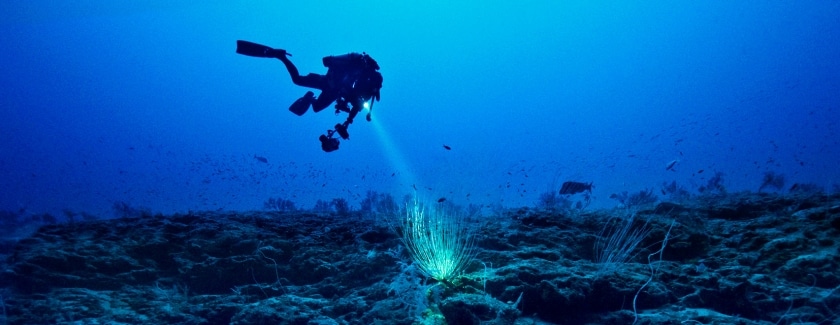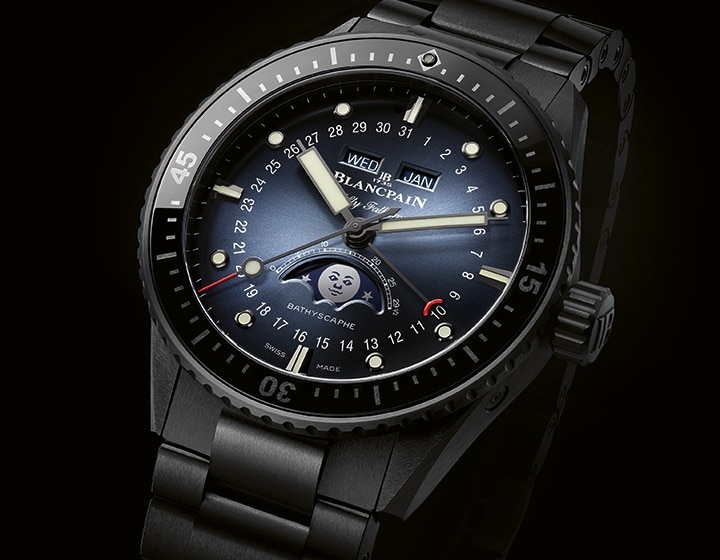Blancpain and Gombessa Exhibition: a meeting with the coelacanth

Questo comunicato non è disponibile in italiano. Voglia consultare la versione inglese (qui di seguito) o la versione francese.
![]()
Physical performance, art, science. Those who excel simultaneously in these three areas are few and far between. Famous underwater biologist and photographer, Laurent Ballesta, is just such a rare individual. The «Gombessa» expedition in April 2013 – made possible with Blancpain’s support – gave him the opportunity of going to the next level of each of his three aspirations. From January 20th to February 23rd 2014, Blancpain is presenting a unique exhibition that retraces the history of these deep dives to meet the coelacanth, incorporating extracts from spectacular films, photographs and original diving equipment.
This prehistoric fish, formerly thought to have disappeared 65 million years ago, is regarded as carrying traces of the passage of fish to the first four-legged vertebrates and therefore hailed as living proof of their exit from water 370 million years ago. The expedition consisted of an international scientific team composed of geneticists, paleontologists and biologists who for the first time were able to study the coelacanth in its natural environment. To accomplish this, the team of divers took on a hostile sea in order to conduct a painstaking mission that involved a great number of tough, technical dives to a depth of more than 120m. The expedition will be turned into one 90-minute documentary film broadcast by Arte in the spring, and another 52-minute film on France 2.
Laurent Ballesta, a pioneer in the world of deep diving, goes to greater depths than the usual limits, discovers a world that was previously inaccessible, and takes the time to observe it. As a biologist, he set himself the target of personally meeting the greatest zoological discovery of the 20th century and exploring its secrets. As an underwater photographer, he shares his discoveries and proves the extent to which a twilight world can dazzle us. At the crossroads of physical exertion, art and science, the exhibition presented at the Cité du Temps retraces the personal quest of Laurent Ballesta who took years to prepare for this encounter that had been a lifelong dream.
A demonstration of a shared passion for the ocean, the exhibition reflects daring and know-how, advanced technique and precision, authenticity and emotion – all elements with which the Blancpain family identifies. A range of elements embodied in the Blancpain X Fathoms, the diving watch and mechanical depth gauge worn by Laurent Ballesta during the expedition and which is also on exhibit as the horological witness of the mission’s success.
Notizie correlate

Blancpain Grande Double Sonnerie
Sembrava impossibile quando l'idea fu lanciata, ma la Grande Double Sonnerie è diventata realtà e costituisce una novità mondiale. Questa nuova grande suoneria, piccola suoneria e ripetizione minuti che può suonare due melodie indipendentemente dalla modalità di suoneria scelta, è associata a un tourbillon volante e ad un calendario perpetuo…

Blancpain Fifty Fathoms
Nato da un’icona che ha segnato la storia dell’orologeria, il Fifty Fathoms Automatique 42mm in acciaio si aggiunge alla collezione permanente di Blancpain. Dopo il successo dell’edizione limitata del 2023 del Fifty Fathoms 70th Anniversary Act 1 e delle versioni in titanio spazzolato grado 23 e oro rosso lanciate l’anno scorso, questo nuovo…

Blancpain Bathyscaphe Quantième Complet Phases de Lune
La Maison Blancpain è lieta di presentare il nuovo Bathyscaphe Quantième Complet Phases de Lune, ora proposto nella versione con bracciale brevettato in ceramica nera dalla lavorazione complessa e cassa realizzata nel medesimo materiale. Questo modello dallo stile sportivo e deciso, ma al contempo di grande eleganza, presenta un quadrante dalle…



